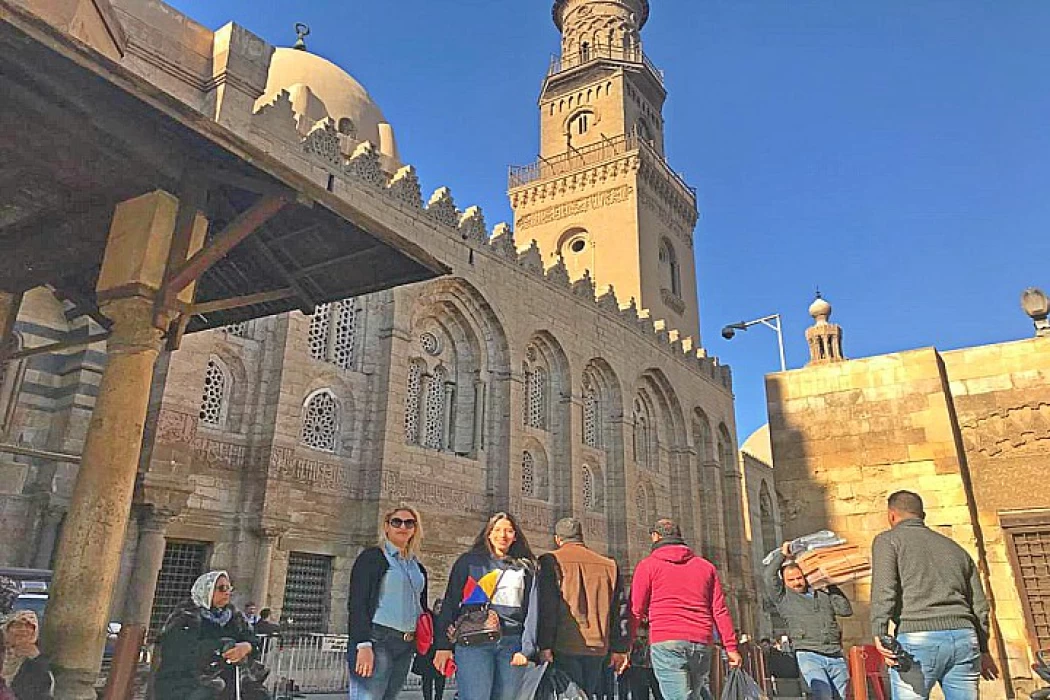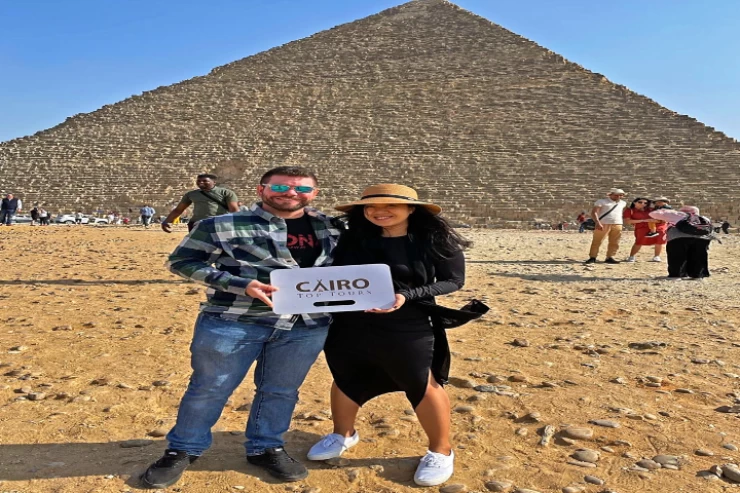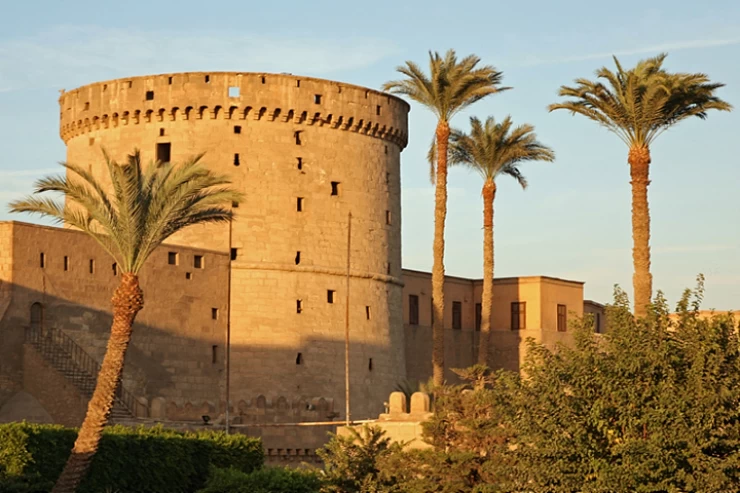
Al-Moez Ladin Allah Al-Fatimi Street.
Al-Mu'izz L-din Allah al-Fatimi Street or the Great Street, the Cairo Kasbah, or the Greater Cairo Kasbah is a street that represents the heart of the Old City of Cairo and which was developed to be an open-air museum of Islamic architecture and antiquities. With the emergence of the city of Cairo during the era of the Fatimid state in Egypt, Al-Mu'izz Street arose, so the layout of the city was pierced by a Main Street stretching from Bab Zuweila south to Bab al-Futuh north parallel to the Gulf, and it was called The Great Street and later the Kasbah of Cairo, With the transformation that Cairo experienced in the early seventh Hijri/thirteenth century AD during the Mamluk era, with the beginning of the Tatar attack on the Levant and Iraq, many of the Levant was displaced to Egypt, so the places passed outside the walls of Cairo, and the emerging neighborhoods surrounded the Fatimid wall of Cairo, and the Great Street was filled with a series of religious, educational, medical, commercial and residential facilities, so that the bulk of the Islamic monuments of Egypt became concentrated within the borders of Mamluk Cairo, and economic activities in this era gathered around the Great Street and its extension outside Bab Zuweila towards the cross and the Citadel, and the Kasbah of Cairo extended beyond its Fatimid walls from the first Husseiniyya northward out of Bab The conquest and even the precious scene to the south are outside Bab Zuweila.
Naming,
Al-Mu'izz street sign for the religion of Allah
The street was originally given several names, namely the Great Street, The Kasbah of Cairo, and the Kasbah of Greater Cairo, and finally, it was named Al-Mu'izz Street by the religion of Allah al-Fatimi in 1937 in honor of the founder of Cairo, and that designation extends from Bab al-Fotouh to Bab Zuweila, including the streets of Bab al-Fotouh, Amir al-joyous, Al-nahassin, Ben Kasserine, as-saja, Ashrafieh, Shawayin, Akkadian, Al-manakhliya, Al-mengidin, Sukariya to Bab zuweila. The current name belongs to the Fatimid caliph Al-Mu'izz of the religion of Allah, Abu Tamim Ma'ad Ibn al-Mansur Ismail ibn al-Qaim in the command of Allah Muhammad ibn al-Mahdi Abdullah Al-Fatimi, whose origin dates back to the island of Sicily while he was born in the city of Mahdia in 319 ah and attributed to Cairo Al-Mu'izzah. He was the first Fatimid caliph to enter Egypt after its conquest in 358 Ah.
History,
The planning of the city of Cairo includes referring to several names such as the line or lane, which included roads, alleys or junctions, peaches, stables, and rehab, which in total formed the general layout of the site. The first Islamic capital in Egypt was Fustat, where the plans were chosen like other Islamic cities, and distributed among the conquering soldiers, and there were also houses of notables gathered around them, of course, loyal to the owners of those houses. Also, the military was the second Islamic capital in Egypt, which was established by the Abbasids, so they established their role, Housing, and barracks of the soldiers, and with the establishment of the city of Tuluniyya, the new emerging city was divided into several sectors inhabited by Obaid Ibn Tulun, Ghulman and Asakreh and made for each sect a cut, then the founding of the city of Cairo came as an extension of the same context, the term،
Al-Muizz Street-Al-Mu'izz ledin Illah Street -. One of the most important historical streets in Egypt and Cairo. When Jawhar Al-saqli built Cairo Al-Mu'azzah, he worked on its northern wall with two doors that are far from each other, namely Bab al-Nasr and Bab al-Fotouh. And in the southern wall, two adjacent doors were opened, which were named Bab zuweila, and a Main Street was opened from Bab al-Futuh to Bab zuweila, and this street was named Al-Mu'izz Street for the religion of Allah.
Al-Mu'izz Street is also known as Al-Azam Street, Al-Qahira Street, and Al-Kasbah Street. The Sicilian essence built on its eastern side a palace for caliph Al-Mu'izz known as the "Great Eastern Palace" and because his son, dear Allah, built in front of him a "small palace known as the little Western Palace". After Saladin destroyed the Fatimid state in Egypt, he, his family and his state order lived in the Grand Palace, and the Palace remained the seat of the Ayyubid rule until the construction of the mountain castle on Mount Mokattam, where King Kamil, Saladin's nephew, lived and shweya shweya the Grand Palace neglected to take care of what it took and adopted neighborhoods, streets, schools and houses in the area. Ma'iz Street is Cairo's Main Street, but its extensions on the one hand of Bab zuweila were a connector for Fustat and on the other hand of Bab al-Fotouh for the AL-husseinieh and Al-Zaher neighborhoods.
Al-Mu'izz Street was full of shops and markets to the extent that the number of shops from Bab al-Futuh to Bab zuweila was about 1200 shops, and the street preferred to retain its place in the Mamluk era and it had necessary traditions to take into account, such as it was forbidden to exceed a loaded camel, a fortress or a covered shed. And there was a law that required shopkeepers to illuminate their shops with jellyfish all night long, and every shopkeeper who visited had two million units dedicated to fighting the fire if it started. There were garbage workers, extras, sweepers and security guards.
Al-Moiz Street is the most famous street in Cairo and Egypt, full of archaeological artifacts from the Middle Ages and the Mamluk era in particular. The street stretches from Bab al-Futuh to Bab Zuweila, and the area includes the streets of Bab al-Futuh, Amir al-Jaish, Al-nahassin, Ben Kasserine, Al-Sagha, Al-Ashrafieh, Al-aqadeen, Al-manakhleh, Al-munajdeen and Al-sakreh.
The monuments mentioned by Al-maqrizi on the street are: al-Hakim Amr Allah mosque, qaytbay agency, Bayt Al-Suhaimi, Suleiman Aga Al-salhdar Mosque, Al-Aqmar mosque, Abdul Rahman Katkhada Avenue, Prince Beshtak Palace, Sultan Qalawun Mosque, Al-Zaher Barqouq school, Saleh Ayyub soil, al-Salhiya School, Al-Kamleh school, Nasser Mohammed bin Qalawun School, Al-Ashraf Barsbay mosque, Sultan Al-Ghouri school and Avenue, hammam the supporter, the Collector-supporter, and others.
During the reign of Minister of Culture Farouk Hosny, a huge effort was made to restore the monuments of the historical street, and its area was developed after it was worn out due to neglect and lack of attention and its shape remained befitting the historical status of Egypt.
Al-Moiz Street is one of the most important areas of Islamic Cairo, which has been included in the UNESCO World Heritage sites since 1979.
Discover the historic charm of El Moez Street in Cairo.
Located deep in the city of Cairo, one can find El Moez Street, a gorgeous time capsule of Egyptian history. El Moez Street, known to many as Al-Muizz li-Din Allah Street, is a remarkable phrase that enables one to traverse the corridors of Islamic history enriched by some of the best examples of the medieval Islamic period, perhaps many mosques, dry and wet bazaars, and a variety of other experiences. In this place, there is a harmonious combination of the historical age and the contemporary, fast-paced city of Cairo, leaving one with the feeling of having traveled to a different era.
The Historical Significance of El Moez Street
Named after Al-Muizz li-Din Allah, the street is an ode to the fourth Fatimid Caliph, who conceived the city of Cairo in the 10th century. The street, originally intended to represent the fulcrum of the new city, later developed into one of the central streets of the medieval Croatian town, filled with houses, mosques, and market halls. El Moez Street retains traces of this history, having changed over centuries as Cairo became an administrative center and later, a commercial center.
Moreover, it is still among the oldest stretches of way in Cairo, which has some historic structures that have been very well preserved. Walking along El Moez Street feels as though one is traversing an open museum of art that tells the story of Egypt’s Islamic Art period, which lasted from the 10th century to the 17th century. The street can support attestation of Cairo’s illustrious past, where it served as a melting pot for different cultures and one of the many fascinating architectural attributes of the street, making it the world’s most beautiful intracity street.
Architectural Marvels Along El Moez Street
El Moez Street is characterized by a wide range of architectural works that include buildings from various Islamic Empires, such as the Fatimid, Mamluk, and Ottoman civilizations. Each structure is unique with detailed decoration and its cultural history. Here are some of the highlights that you should not miss while walking down the street:
Al Azahar
Though slightly tucked away from the main street, Al-Azhar Mosque is just within walking distance, and it is one of the oldest and most revered centers of worship located in the Islamic World. Constructed in 970 A. Dominated by the center of Islamic culture, Al-Azhar, for quite a few ages, this mosque is remarkable for its incredible design. The minarets are elegant, and the mosque’s courtyard is vast.
Al-Hakim Mosque
Al-Hakim Mosque is dedicated to Al-Hakim bi-Amr Allah, who ruled in the East for some time. This edifice was built during the short period when the Fatimid Empire flourished and is an example of Fatimid architecture. It has giant minarets, a grand prayer place, and decorated vaults, landscapes, and corridors built in the 11th century. This mosque is still intact even after undergoing several restorations in the course of its history, which has managed to keep the historical part of Old Kam, so it is still preserved for the coming generations.
Sabil-Kuttab: an 18th-century structure within the Katkhuda complex
This remarkable building dates back to the 18th century and is a typical example of Ottoman-styled structures. A “sail” is a dome where people fetch drinking water free of charge, while a “kuttab” is a place for teaching the children the Quran. The elaborately decorated ceiling of the building, embellished in marble, tiles, and other materials, draws the attention of many people, making it a great site for taking photographs.
Qalawun Foundation
Among the most remarkable exercises of architecturally constructed space, which embraces a mosque, a madrasa, and an institution, is the Qalawun complex. The complex was built during the era of Sultan Qalawun in the 13th century. It is typical of Mamluk's architectural style. The artistic complexity of this institutional building is beyond comprehension, having stunning intricate woodwork, stone, and marble work, as well as beautiful domes.
Home of Al Suhaymi
The house has been fully restored to its glory during the Ottoman period, showcasing the life of a prosperous 17th-century merchant. The house to this – Bayt Al-Suhaymi – comes with wooden mesh windows, a beautiful inner garden, and skillfully decorated interior signs that carry the touch of the old Cairo charm.
Situated a few meters from El Moez Street is Khan El-Khalili, a marketplace that allows tourists to buy authentic Egyptian goods, such as jewelry, spice, cloth, antiques, and much more. Filled with colors, choking with scents, filled with shouting and noise—this is the market, where people come to buy and sell.
El Moez Street is not only a great number of historical edifices standing side by side, but also a lively place full of activity for the natives and visitors around the year. Throughout the year, this street experiences different cultures in the form of arts, theater, music, folklore, and other forms of entertainment.
As you stroll through the street, you’ll find musicians playing Egyptian traditional music, artists at work, and the aroma of street foods such as falafel, koshari, and desserts like basbousa and konafa fills the air. As night falls, lanterns and colored lights are turned on as they embellish the street, making it attractive turned beautiful.
The Tannoura Dance Show is among the most done activities along El Moez Street. This is a Sufi worship dance that is performed by trained dervishes in multicolor skirts to the traditional music. This is an enjoyable experience that one has to witness. This performance normally happens at Wekalet El Ghouri, which is an old caravanserai recently used as a cultural center.


















